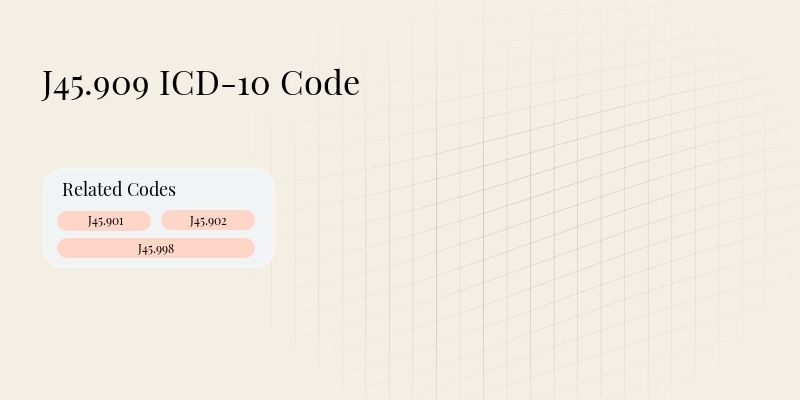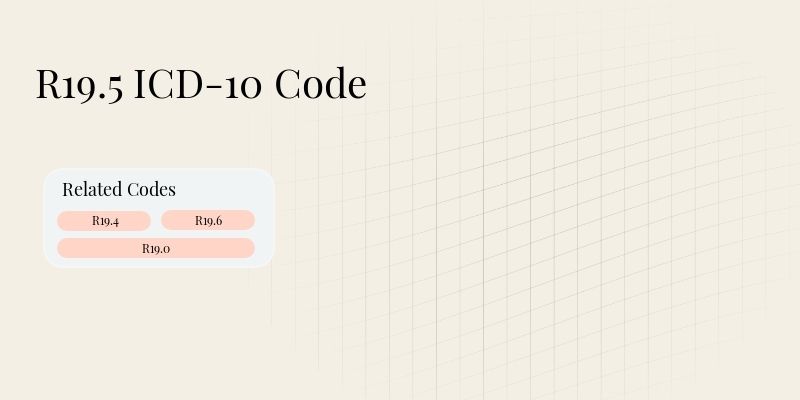
E78.1 ICD-10 Code: Hypertriglyceridemia

Key Takeaways
- What E78.1 ICD-10 Code Covers: This code specifically denotes pure hyperglyceridemia, a condition characterized by elevated levels of triglycerides in the bloodstream without the presence of other lipid abnormalities. It is crucial for accurate diagnosis and treatment.
- Session duration requirements: Generally, this code is applicable when a patient is diagnosed during an office visit or consultation, which typically lasts between 15-30 minutes, allowing time for assessment and management.
- Who can use the code: This code can be used by healthcare professionals such as primary care physicians, endocrinologists, and cardiologists who diagnose and manage lipid disorders.
- Best practice for proper use: Ensure that the patient's medical record includes detailed documentation of triglyceride levels, symptoms, and any relevant medical history to support the diagnosis of pure hyperglyceridemia.
- Example of actual usage: A patient presents with elevated triglyceride levels of 300 mg/dL during a routine lipid panel. The physician notes the findings and diagnoses the patient with pure hyperglyceridemia, leading to appropriate treatment and lifestyle recommendations.
What is E78.1 ICD-10 Code
The E78.1 ICD‑10 code is defined as pure hyperglyceridemia, which refers to an isolated elevation of triglycerides in the blood without concurrent elevations of cholesterol or other lipids. This condition can significantly increase the risk of cardiovascular diseases and pancreatitis.
Proper classification of this condition is vital for effective management and treatment planning. Understanding the implications of pure hyperglyceridemia allows healthcare professionals to tailor interventions, including lifestyle modifications and medication, aimed at reducing triglyceride levels and overall cardiovascular risk.
Services Covered Under E78.1 ICD-10 Code
This section outlines the services that may be covered when using the E78.1 code.
Service | Description | Typical Use Case |
|---|---|---|
Lipid Panel | A blood test measuring triglycerides, cholesterol levels, and other lipids. | Performed during annual health checks or for patients with risk factors. |
Dietary Counseling | Consultation to educate patients on dietary changes to manage triglyceride levels. | Recommended for patients diagnosed with hyperglyceridemia. |
Medication Management | Prescribing medications that lower triglyceride levels. | Used for patients with persistently high triglycerides despite lifestyle changes. |
Who Can Use the E78.1 ICD-10 Code?
The E78.1 code is applicable to various healthcare providers involved in diagnosing and managing lipid disorders.
- Primary Care Physicians: Typically the first point of contact, they can diagnose and initiate treatment plans.
- Endocrinologists: Specialists who may manage patients with metabolic disorders, including lipid abnormalities.
- Cardiologists: Focus on heart health and may see patients with hyperglyceridemia as part of cardiovascular risk assessment.
- Nutritionists: Provide dietary counseling to help patients lower triglyceride levels through nutrition.
How to Use E78.1 ICD-10 Code
Correct application of this code requires specific documentation and clinical scenarios.
- Diagnosis Documentation: Clearly state the triglyceride levels and any related symptoms. For instance, if a patient presents with a triglyceride level of 250 mg/dL and symptoms of fatigue, document both clearly in the medical record.
- Associated Conditions: If applicable, document any other health conditions that may influence treatment. For example, a patient with diabetes may require a different management approach for hyperglyceridemia.
- Follow-up Appointments: Schedule and document follow-up visits to monitor triglyceride levels. For instance, after initiating treatment, a follow-up visit should be noted to assess treatment efficacy.
Reimbursement Rates for E78.1 ICD-10 Code
Insurance Type | Reimbursement Rate |
|---|---|
Medicare | $150 |
Medicaid | $120 |
Private Insurance | $200 |
Disclaimer: Reimbursement rates can change frequently and are influenced by various factors, including geographical location and specific insurance policies. This article aims to provide average rates and will be updated accordingly.
Benefits of E78.1 ICD-10 Code
This code offers several benefits that enhance patient care and management.
Benefit | Description |
|---|---|
Accurate Diagnosis | Facilitates precise identification of pure hyperglyceridemia, leading to targeted treatment. |
Improved Patient Outcomes | Allows healthcare providers to implement interventions that lower triglyceride levels, reducing cardiovascular risks. |
Enhanced Billing Accuracy | Ensures that medical billing reflects appropriate treatment and diagnostic services rendered for hyperglyceridemia. |
Common Mistakes to Avoid with E78.1 ICD-10 Code
Misuse of this code can lead to audits and claim denials. Awareness of common errors is essential to ensure accurate coding and billing.
- Incorrect Documentation: Failing to document triglyceride levels can result in claim denials. For example, a physician may note symptoms but not include lab results.
- Using the Wrong Code: Confusing E78.1 with other lipid disorder codes can lead to billing errors. A clinician might mistakenly use a code for mixed hyperlipidemia instead of pure hyperglyceridemia.
- Not Following Up: Neglecting to schedule follow-up visits after initial diagnosis can hinder patient management. A provider may see a patient once but fail to monitor progress effectively.
- Inadequate Patient Education: Failing to provide proper dietary and lifestyle recommendations can affect treatment success. A nutritionist might not discuss the importance of low-fat diets with patients diagnosed with hyperglyceridemia.
E78.1 ICD-10 Code vs other codes
Understanding how E78.1 compares to similar codes is crucial for accurate coding practices.
ICD-10 Code | Description | Key Differences |
|---|---|---|
E78.1 | Pure hyperglyceridemia | Isolated increase in triglycerides without cholesterol elevation. |
E78.2 | Mixed hyperlipidemia | Elevated triglycerides combined with elevated cholesterol levels. |
E78.0 | Pure hypercholesterolemia | High cholesterol without triglyceride elevation. |
Conclusion
This blog post has provided a comprehensive overview of the E78.1 ICD‑10 code, which signifies pure hyperglyceridemia. Understanding this code is essential for healthcare professionals involved in diagnosing and managing patients with elevated triglyceride levels. Accurate documentation and appropriate use of this code can lead to improved patient outcomes and billing accuracy. Moreover, awareness of common mistakes and how this code compares to similar codes enhances the overall effectiveness of medical coding practices. By adhering to best practices and staying informed about changes in reimbursement rates, healthcare providers can ensure that they are delivering optimal care while accurately reflecting the services provided.
Disclaimer: This article is for informational purposes only and does not constitute legal or medical advice. Always consult professional guidelines and regulatory bodies for specific compliance requirements.
Frequently Asked Questions
Reduce burnout,
improve patient care.
Join thousands of clinicians already using AI to become more efficient.

90791 CPT Code: Guide to Initial Intake Appointment
Discover essential insights on the 90791 CPT code for mental health professionals. Enhance your practice and navigate billing with confidence.

J45.909 ICD-10 Code: Reactive Airway Disease
Discover essential insights on the J45.909 ICD-10 Code code for health professionals. Enhance your practice and navigate billing with confidence.

R19.5 ICD-10 Code: Blood in Stool
Discover essential insights on the R19.5 ICD-10 Code code for health professionals. Enhance your practice and navigate billing with confidence.
